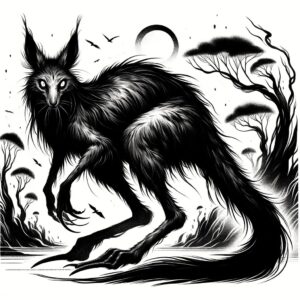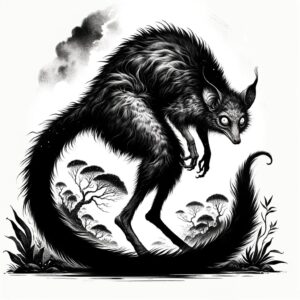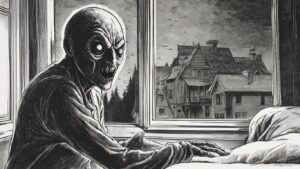Table of Contents
In the heart of the Philippines, a land rich in diverse traditions and stories, resides an enigmatic creature that has captivated the imaginations of generations – the mysterious Sigbin. Within the tapestry of Filipino folklore, the Sigbin stands as an icon of the supernatural. It blends eerie attributes and chilling tales into a narrative that continues to intrigue and terrify. Consequently, this mythical being, with its peculiar appearance, chilling abilities, and cultural significance, beckons us into the depths of Philippine mythology.
Origins
To unravel the enigma of the Sigbin, we must first delve into its origins and evolution. The Sigbin’s existence is deeply rooted in the collective consciousness of the Visayan people, with its legends dating back centuries. Moreover, the term “Sigbin” is believed to have originated from the Spanish word “chupar,” meaning “to suck,” alluding to its reputed blood-sucking tendencies.
The Sigbin’s beginnings can be traced to the amalgamation of pre-colonial animistic beliefs and the influence of Spanish colonization in the Philippines during the 16th century. This fusion of cultures gave rise to a myriad of mythical creatures, including the Sigbin, as native Visayan folklore intertwined with Catholicism and Spanish traditions.
This blending of cultures served as a catalyst for the Sigbin’s transformation, allowing it to emerge as a symbol of the complex interplay between indigenous beliefs and external influences. Consequently, it epitomizes the resilience of traditional folklore in the face of modernization.
Appearance

The Sigbin’s appearance combines grotesque features reminiscent of various animals, such as a hornless goat, a kangaroo, and a bat, evoking a profound sense of dread. It stands at approximately two feet tall and exhibits a distinctive gait – it moves in reverse, with its head tucked between its hind legs. This peculiar gait allows the Sigbin to glide silently and inconspicuously, leaving no trace of its presence and intensifying the aura of foreboding that envelops it.
Adding to its eerie countenance, the Sigbin possesses an elongated tongue, akin to that of certain reptiles. This tongue is employed to siphon the blood of unsuspecting victims, a macabre aspect of the creature. This macabre aspect draws eerie parallels with vampire lore and taps into the inherent fear of the night. As it preys upon children and slumbering individuals, it symbolizes vulnerability in the darkness.
The Sigbin’s eyes, often depicted as large and bulging, resemble those of nocturnal animals, such as owls or cats. They emit a haunting, luminous glow in the dark, which further heightens the spine-tingling effect of its presence. In some accounts, it portrays horn-like protrusions on its head, reminiscent of the twisted horns of certain demonic creatures, contributing to its menacing appearance.
Abilities and Behavior
The Sigbin’s capabilities extend beyond its eerie exterior. Moreover, its nocturnal nature and stealthy movements bestow upon it an air of cunning and secrecy. Believed to be highly elusive, it eludes easy encounters. Furthermore, its penchant for the darkness embodies the unknown perils lurking in the shadows.
One of the most feared aspects of the Sigbin is its insatiable thirst for blood. It selectively targets children and individuals during their slumber, infiltrating homes under the cover of night to satisfy its gruesome appetite. This malevolent facet of the creature taps into primal anxieties associated with nighttime vulnerability, serving as a stark reminder of the dangers concealed by the veil of darkness.
In Filipino folklore, there exists a prevailing belief that the Sigbin can be controlled or summoned by witches, sorcerers, or practitioners of black magic. This notion perpetuates superstitions and fosters a deep-seated fear of individuals presumed to possess the power to manipulate its malevolent forces. Consequently, this underscores the Sigbin’s profound significance in the realm of supernatural beliefs, emphasizing the extent to which it has become ingrained in the collective psyche of Filipino culture.
Symbols and Cultural Significance

The Sigbin serves as a symbol of the unknown, fear of the night, and the mysteries that shroud the realm beyond the visible. It represents the anxieties and uncertainties lurking in the dark, whether they be tangible threats or intangible fears that haunt the human psyche.
Within the cultural mosaic of the Philippines, the Sigbin signifies a connection to the past, serving as a testament to the intricate interweaving of indigenous beliefs, Spanish colonization, and the enduring legacy of folklore. This unique blend embodies the fusion of diverse cultural elements that have contributed to the tapestry of Filipino identity over centuries. It underscores the enduring power of traditional beliefs in a modern world.
The presence of the Sigbin in local tales, legends, and superstitions not only underscores its cultural impact but also imparts valuable lessons. Furthermore, it functions as a cautionary narrative for children, effectively reminding them of the perils concealed by the night, instilling a sense of vigilance and circumspection. In addition, parents and elders diligently recount stories of the Sigbin to ensure that the younger generation remains guarded and protected. Consequently, this oral transmission of tales serves as a profound means of preserving cultural traditions, ensuring that they endure and thrive through the passage of time.
Myths and Stories
The Sigbin has etched its indelible mark on Filipino folklore, and its stories persistently transcend generations. Here are some noteworthy myths and narratives associated with this enigmatic creature:
The Sigbin and the Witch: In this tale, a malevolent witch employs a Sigbin to execute her malevolent commands, unleashing terror upon a village. The story serves as a cautionary admonition against delving into the dark arts and the dire consequences of harnessing the power of the Sigbin for nefarious ends.
The Night Visitor: This narrative recounts a family’s harrowing encounter with a Sigbin in the dead of night. It vividly portrays the fear and helplessness experienced when confronted with the unknown and the supernatural.
The Sigbin’s Curse: In this legend, a Sigbin’s curse plagues a village, setting off a series of unfortunate events and illnesses. The villagers must seek the guidance of a sagacious elder to rid themselves of the curse, accentuating the significance of unity and collective action in overcoming adversity.
These tales serve as both instructive parables and a conduit for preserving cultural traditions, as they explore themes of f
ear, morality, and the repercussions of human actions.
The Enduring Mystique
The Sigbin stands as a testament to the timeless potency of folklore and mythology in shaping the beliefs and perceptions of a people. Furthermore, its grotesque appearance, bloodthirsty proclivities, and predilection for the night have rendered it an iconic figure in Filipino culture, captivating the minds of young and old alike.
Beneath its chilling veneer, the Sigbin embodies the apprehensions and uncertainties that have haunted humanity across epochs. Moreover, it personifies the fear of the uncharted, the vulnerability that accompanies nightfall, and the perils lurking in the shadows. As a symbol of cultural identity and a bridge to the past, the Sigbin remains instrumental in safeguarding and transmitting the rich tapestry of Filipino folklore. Consequently, it ensures that its narratives and wisdom endure through generations.
FAQ
Where is the Sigbin believed to be found?
The Sigbin is believed to inhabit the Visayan region of the Philippines, particularly in places like Cebu, Leyte, and Samar.
What are the Sigbin's abilities?
The Sigbin is said to move silently by walking backward, has a long tongue used to suck the blood of victims, and its eyes are described as large and glowing in the dark.
Is the Sigbin real?
No, the Sigbin is purely a creature of folklore and mythology, and there is no scientific evidence to support its existence.
What is the cultural significance of the Sigbin?
The Sigbin serves as a symbol of the unknown, fear of the night, and the mysteries that lie beyond the visible. It also plays a role in cautionary tales and the preservation of Filipino cultural traditions.




